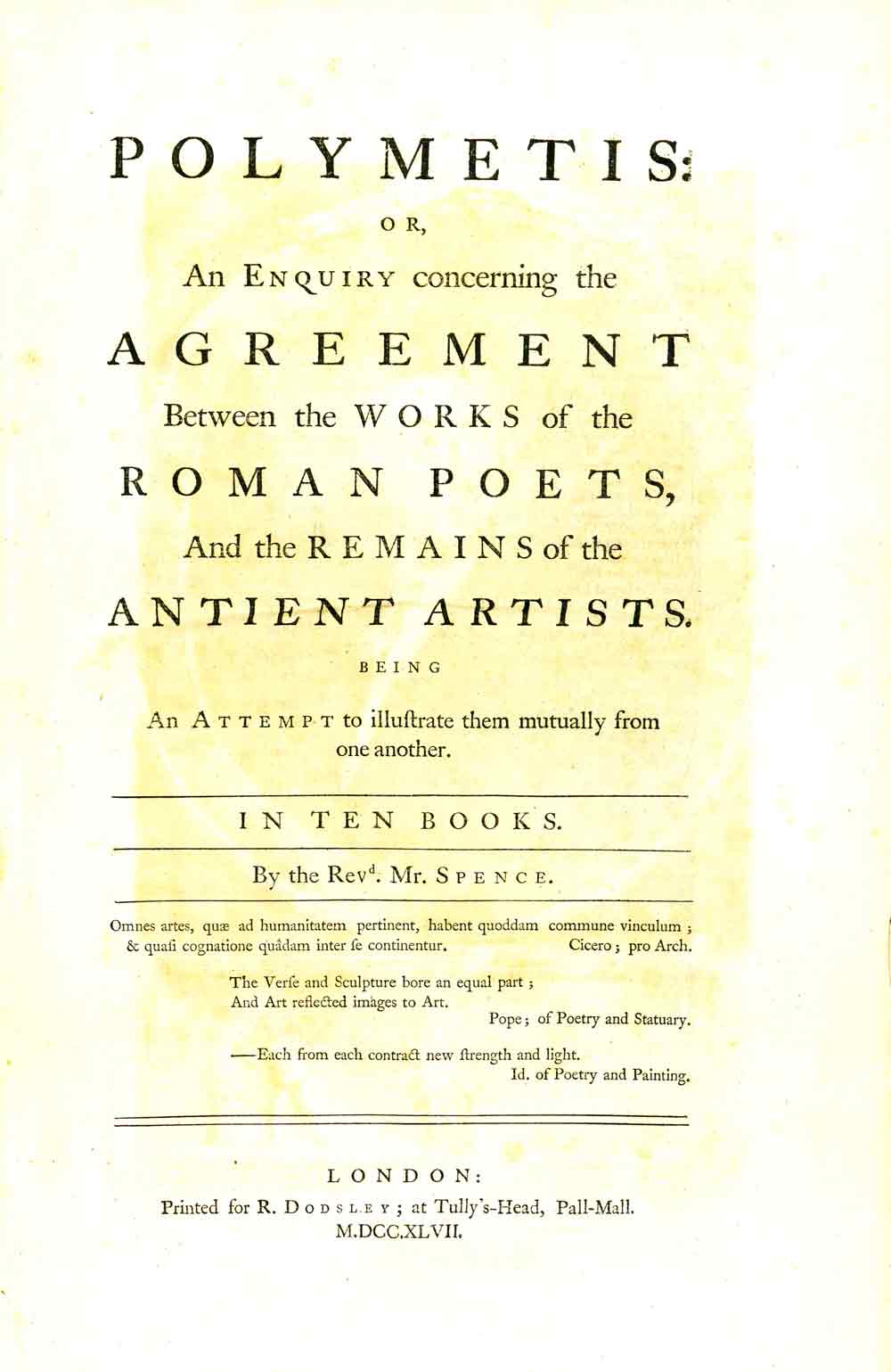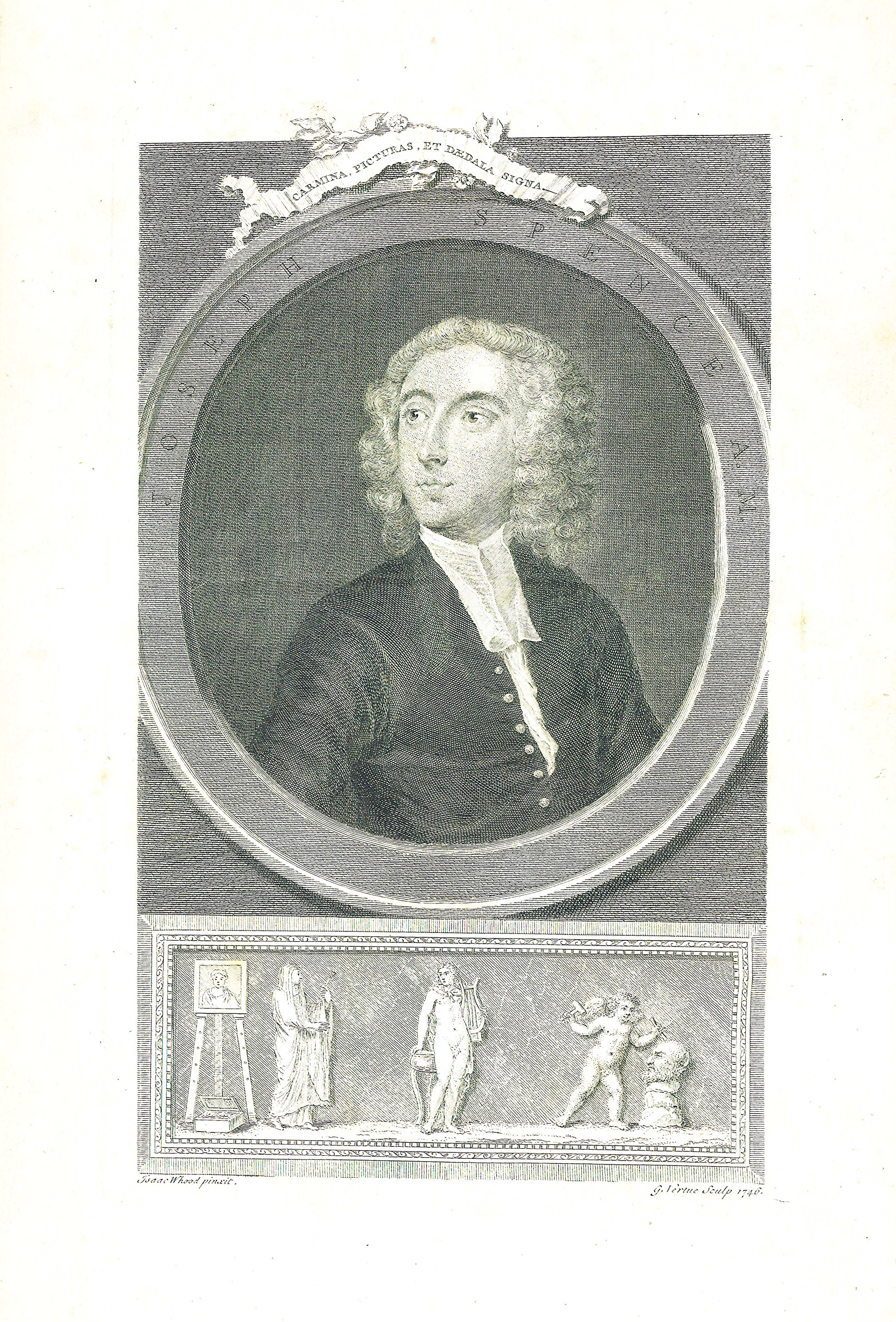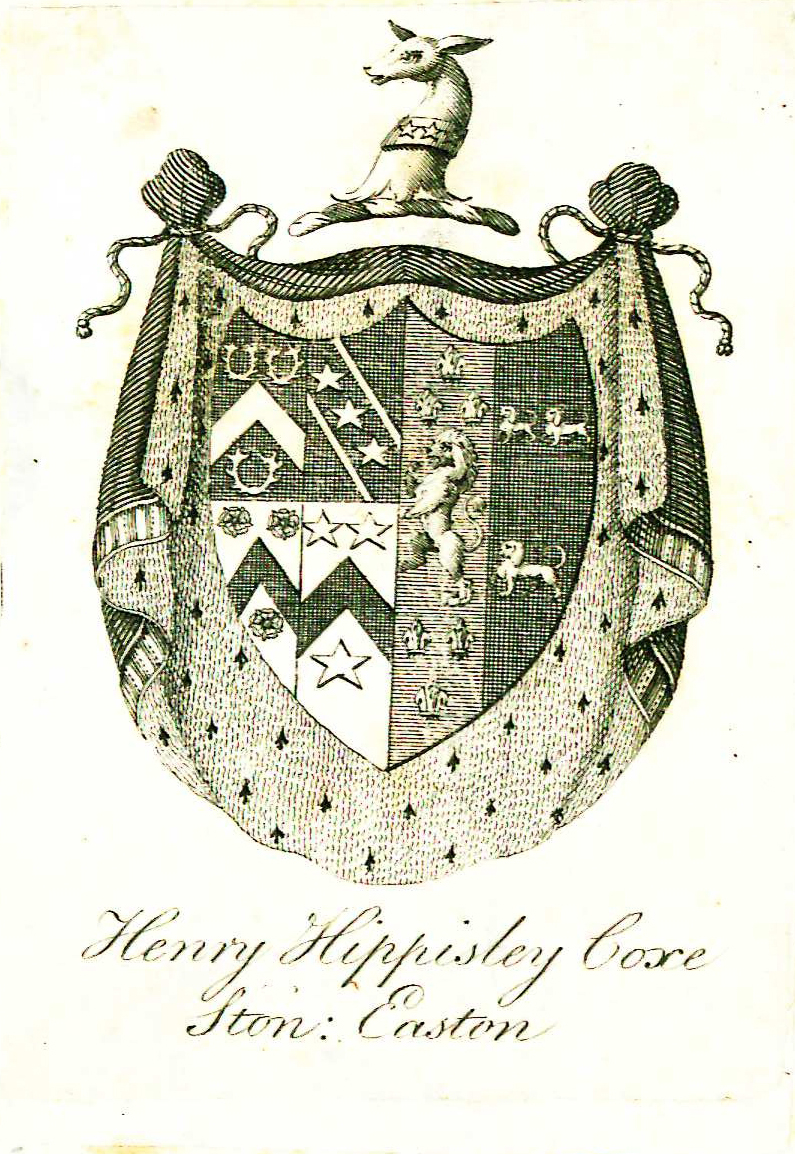Difference between revisions of "Polymetis"
(→Evidence for Inclusion in Wythe's Library) |
|||
| Line 14: | Line 14: | ||
|pages=xii, 361 | |pages=xii, 361 | ||
|desc=Folio (42 cm.) | |desc=Folio (42 cm.) | ||
| − | }}[http://en.wikipedia.org/wiki/Joseph_Spence_%28author%29 Joseph Spence] (1699-1748) was an English scholar of both literature and anecdote, who spent the majority of his life traveling throughout Europe. During these travels he wrote many of his most distinguished works and received inspiration for other literary works and lectures which he went on to give at Oxford. Of note is Spence’s close relationship with [http://en.wikipedia.org/wiki/Alexander_Pope Alexander Pope], a fellow literary figure who became a life-long friend to Spence and heavily influenced his work. Due in part to this friendship, Spence was elected as the Oxford chair of poetry in 1728 and he went on to become a professor of modern history at Oxford in 1742. After publishing Polymetis, Spence used his profits to fulfill his love of gardening and continued to produce literary works (both published and unpublished) until his death in 1748.<ref> James Sambrook, [http://www.oxforddnb.com/view/article/26111 ‘Spence, Joseph (1699–1768)’], Oxford Dictionary of National Biography, Oxford University Press, 2004; online edn, May 2010, accessed 11 June 2013.</ref><br /> | + | }}[[File:SpencePolymetis1747Frontispiece.jpg|left|thumg|250px|<center>Frontispiece portrait of Joseph Spence.</center>]][http://en.wikipedia.org/wiki/Joseph_Spence_%28author%29 Joseph Spence] (1699-1748) was an English scholar of both literature and anecdote, who spent the majority of his life traveling throughout Europe. During these travels he wrote many of his most distinguished works and received inspiration for other literary works and lectures which he went on to give at Oxford. Of note is Spence’s close relationship with [http://en.wikipedia.org/wiki/Alexander_Pope Alexander Pope], a fellow literary figure who became a life-long friend to Spence and heavily influenced his work. Due in part to this friendship, Spence was elected as the Oxford chair of poetry in 1728 and he went on to become a professor of modern history at Oxford in 1742. After publishing Polymetis, Spence used his profits to fulfill his love of gardening and continued to produce literary works (both published and unpublished) until his death in 1748.<ref> James Sambrook, [http://www.oxforddnb.com/view/article/26111 ‘Spence, Joseph (1699–1768)’], Oxford Dictionary of National Biography, Oxford University Press, 2004; online edn, May 2010, accessed 11 June 2013.</ref><br /> |
<br /> | <br /> | ||
''Polymetis: or, An Enquiry Concerning the Agreement between the Works of the Roman Poets, and the Remains of the Antient Artists, Being an Attempt to Illustrate Them Mutually from One Another'', published in 1747, reflected Spence’s first visit to Italy and draws upon the works he observed while there. Written in dialogue form, this work provides a history and criticism on subjects such as Roman sculpture, mythological art, and Latin poetry, complete with illustrations.<ref> Joseph Spence, Polymetis, (London: R. Dodsley , 1747).</ref> With a special focus on how these works of art and literature interplay and provide explanations for each other, Spence, as the title suggests, “attempt[s] to illustrate them mutually from one another.” Polymetis was significant both in the education system for decades following its publication and for [http://en.wikipedia.org/wiki/John_Keats Keats], who used Polymetis as a guide to ancient mythological imagery.<ref>James Sambrook, “Spence, Joseph."</ref> | ''Polymetis: or, An Enquiry Concerning the Agreement between the Works of the Roman Poets, and the Remains of the Antient Artists, Being an Attempt to Illustrate Them Mutually from One Another'', published in 1747, reflected Spence’s first visit to Italy and draws upon the works he observed while there. Written in dialogue form, this work provides a history and criticism on subjects such as Roman sculpture, mythological art, and Latin poetry, complete with illustrations.<ref> Joseph Spence, Polymetis, (London: R. Dodsley , 1747).</ref> With a special focus on how these works of art and literature interplay and provide explanations for each other, Spence, as the title suggests, “attempt[s] to illustrate them mutually from one another.” Polymetis was significant both in the education system for decades following its publication and for [http://en.wikipedia.org/wiki/John_Keats Keats], who used Polymetis as a guide to ancient mythological imagery.<ref>James Sambrook, “Spence, Joseph."</ref> | ||
| − | + | {{BookPageBookplate | |
| + | |imagename=SpencePolymetis1747Bookplate.jpg | ||
| + | |display=left | ||
| + | |caption=Armorial bookplate of Henry Hippisley Coxe, front pastedown. | ||
| + | }} | ||
==Evidence for Inclusion in Wythe's Library== | ==Evidence for Inclusion in Wythe's Library== | ||
| − | Listed in the [[Jefferson Inventory]] of [[Wythe's Library]] as "Spence's Polymetis. fol." and kept by [[Thomas Jefferson]]. Jefferson sold a copy to the Library of Congress | + | Listed in the [[Jefferson Inventory]] of [[Wythe's Library]] as "Spence's Polymetis. fol." and kept by [[Thomas Jefferson]]. Jefferson sold a copy to the Library of Congress but it no longer exists to verify the edition or Wythe's previous ownership.<ref>E. Millicent Sowerby, ''Catalogue of the Library of Thomas Jefferson'', 2nd ed. (Charlottesville: University Press of Virginia, 1983), 4:389 [no.4230].</ref> The [https://digitalarchive.wm.edu/handle/10288/13433 Brown Bibliography]<ref> Bennie Brown, "The Library of George Wythe of Williamsburg and Richmond," (unpublished manuscript, May, 2012) Microsoft Word file. Earlier edition available at: https://digitalarchive.wm.edu/handle/10288/13433</ref> lists the first edition (1747) based on E. Millicent Sowerby's entry in ''Catalogue of the Library of Thomas Jefferson''. [http://www.librarything.com/profile/GeorgeWythe George Wythe's Library]<ref>''LibraryThing'', s. v. [http://www.librarything.com/profile/GeorgeWythe "Member: George Wythe"], accessed on April 21, 2013.</ref> on LibraryThing indicates "Precise edition unknown. Folio editions were published by the Dodsleys in 1747, 1755, and 1774." |
Historians believe Wythe used ''Polymetis'' to design the seal of the Commonwealth of Virginia.<ref>FIND REFERENCE.</ref> John Page wrote Jefferson, | Historians believe Wythe used ''Polymetis'' to design the seal of the Commonwealth of Virginia.<ref>FIND REFERENCE.</ref> John Page wrote Jefferson, | ||
<blockquote>We are very much at a loss here for an Engraver to make our Seal. Mr. Wythe and myself have therefore thought it proper to apply to you to assist us in this Business. Can you get the work done in Philadelphia? The inclosure [sic] will be all the Directions you will require. He may be at a loss for a virtue and libertas, but you may refer him to Spence's ''Polymetis'' which must be in some Library in Philadelphia.<ref>''The Papers of Thomas Jefferson'', Julian P. Boyd, ed. (Princeton: Princeton University Press, 1950), 1:468.VERIFY</ref></blockquote> | <blockquote>We are very much at a loss here for an Engraver to make our Seal. Mr. Wythe and myself have therefore thought it proper to apply to you to assist us in this Business. Can you get the work done in Philadelphia? The inclosure [sic] will be all the Directions you will require. He may be at a loss for a virtue and libertas, but you may refer him to Spence's ''Polymetis'' which must be in some Library in Philadelphia.<ref>''The Papers of Thomas Jefferson'', Julian P. Boyd, ed. (Princeton: Princeton University Press, 1950), 1:468.VERIFY</ref></blockquote> | ||
| − | + | File:SpencePolymetis1747Fortitudo.jpg | |
| + | File:SpencePolymetis1747Parcae.jpg | ||
==Description of the Wolf Law Library's copy== | ==Description of the Wolf Law Library's copy== | ||
Bound in contemporary calf with gilt spine and red spine label.<br /> | Bound in contemporary calf with gilt spine and red spine label.<br /> | ||
Revision as of 17:00, 24 March 2014
by Joseph Spence
| Polymetis | |
|
Title page from Polymetis, George Wythe Collection, Wolf Law Library, College of William & Mary. | |
| Author | Joseph Spence |
| Published | London: R. Dodsley |
| Date | 1747 |
| Edition | First |
| Language | English |
| Pages | xii, 361 |
| Desc. | Folio (42 cm.) |
Polymetis: or, An Enquiry Concerning the Agreement between the Works of the Roman Poets, and the Remains of the Antient Artists, Being an Attempt to Illustrate Them Mutually from One Another, published in 1747, reflected Spence’s first visit to Italy and draws upon the works he observed while there. Written in dialogue form, this work provides a history and criticism on subjects such as Roman sculpture, mythological art, and Latin poetry, complete with illustrations.[2] With a special focus on how these works of art and literature interplay and provide explanations for each other, Spence, as the title suggests, “attempt[s] to illustrate them mutually from one another.” Polymetis was significant both in the education system for decades following its publication and for Keats, who used Polymetis as a guide to ancient mythological imagery.[3]
Evidence for Inclusion in Wythe's Library
Listed in the Jefferson Inventory of Wythe's Library as "Spence's Polymetis. fol." and kept by Thomas Jefferson. Jefferson sold a copy to the Library of Congress but it no longer exists to verify the edition or Wythe's previous ownership.[4] The Brown Bibliography[5] lists the first edition (1747) based on E. Millicent Sowerby's entry in Catalogue of the Library of Thomas Jefferson. George Wythe's Library[6] on LibraryThing indicates "Precise edition unknown. Folio editions were published by the Dodsleys in 1747, 1755, and 1774."
Historians believe Wythe used Polymetis to design the seal of the Commonwealth of Virginia.[7] John Page wrote Jefferson,
We are very much at a loss here for an Engraver to make our Seal. Mr. Wythe and myself have therefore thought it proper to apply to you to assist us in this Business. Can you get the work done in Philadelphia? The inclosure [sic] will be all the Directions you will require. He may be at a loss for a virtue and libertas, but you may refer him to Spence's Polymetis which must be in some Library in Philadelphia.[8]
File:SpencePolymetis1747Fortitudo.jpg File:SpencePolymetis1747Parcae.jpg
Description of the Wolf Law Library's copy
Bound in contemporary calf with gilt spine and red spine label.
View this book in William & Mary's online catalog.
References
- ↑ James Sambrook, ‘Spence, Joseph (1699–1768)’, Oxford Dictionary of National Biography, Oxford University Press, 2004; online edn, May 2010, accessed 11 June 2013.
- ↑ Joseph Spence, Polymetis, (London: R. Dodsley , 1747).
- ↑ James Sambrook, “Spence, Joseph."
- ↑ E. Millicent Sowerby, Catalogue of the Library of Thomas Jefferson, 2nd ed. (Charlottesville: University Press of Virginia, 1983), 4:389 [no.4230].
- ↑ Bennie Brown, "The Library of George Wythe of Williamsburg and Richmond," (unpublished manuscript, May, 2012) Microsoft Word file. Earlier edition available at: https://digitalarchive.wm.edu/handle/10288/13433
- ↑ LibraryThing, s. v. "Member: George Wythe", accessed on April 21, 2013.
- ↑ FIND REFERENCE.
- ↑ The Papers of Thomas Jefferson, Julian P. Boyd, ed. (Princeton: Princeton University Press, 1950), 1:468.VERIFY


